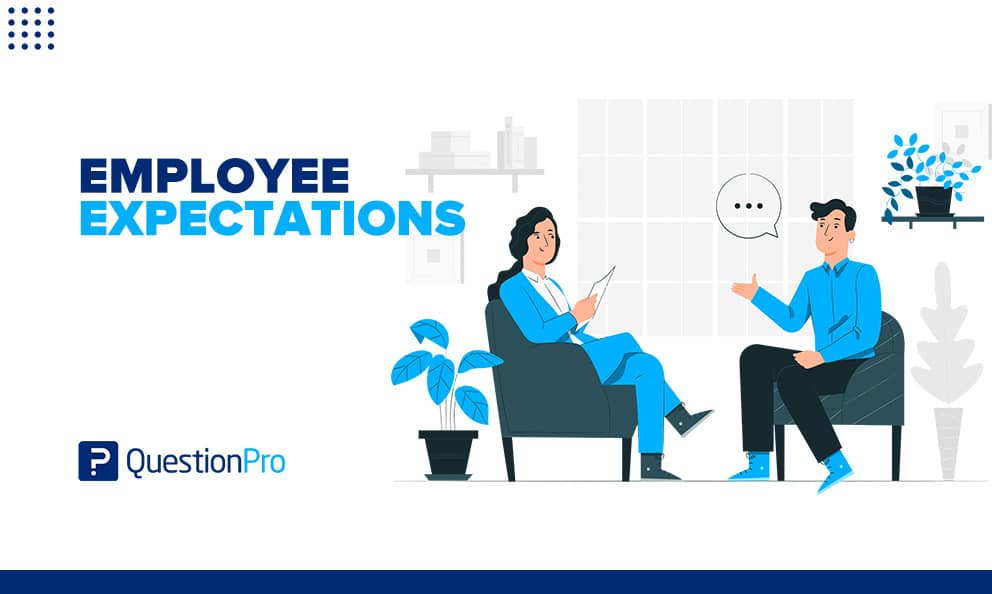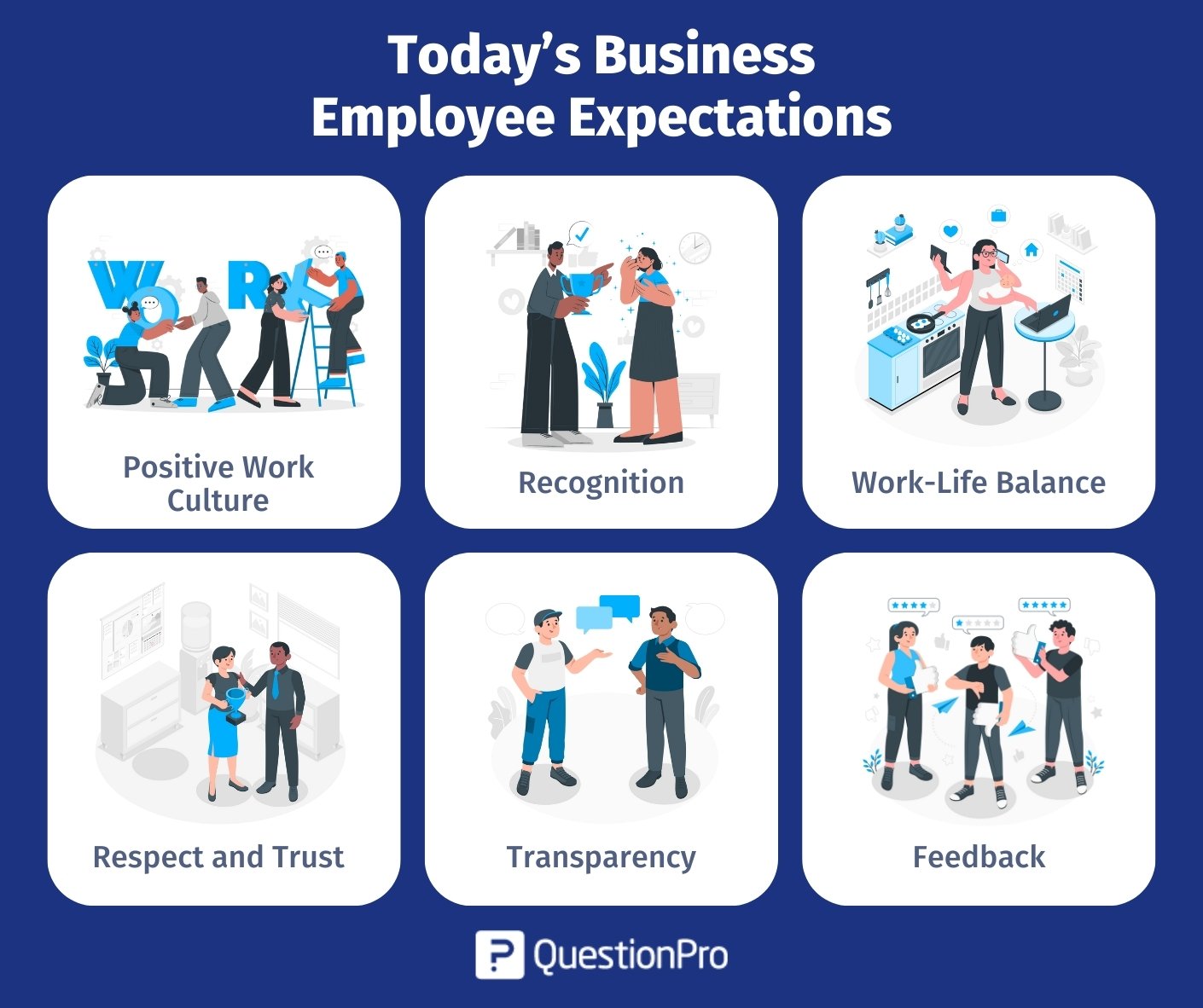
Setting clear expectations for your employees is an important responsibility many business owners overlook. Clear employee expectations benefit not only your employees but also your company.
Your employees are your company’s most valuable asset. They are the ones who bring the energy, skills, and experience to propel your company forward and build success in your market. They are also the ones who will make or break your brand’s corporate reputation in the eyes of your customers. And anyway, “happy employees make happy customers” is a statement we’ve all heard.
What are Employee Expectations
Employee expectations are the assumptions, anticipations, and behaviors employees expect their employers to take. This dramatically affects employee satisfaction. Various factors, including personal values, career goals, past experiences, and cultural influences shape these expectations.
Because when an employee receives what they expect from their employer, they usually feel more valued. Understanding and managing employee expectations is essential for fostering a positive work environment, promoting job satisfaction, and retaining talented individuals within an organization.
Why is it Necessary to Manage Employee Expectations?
Strong employee expectations management will reduce turnover and improve retention rates. According to one study, 48 percent of employees left a job because it did not meet their expectations.
The likelihood of job dissatisfaction decreases with increased transparency about the nature of job satisfaction, the demands and pressures, and opportunities for advancement. Employee morale rises when employees clearly understand what to expect from their company. Higher confidence leads to greater team unity, purpose, and productivity.
Managing and setting employee expectations is crucial for several reasons in the workplace. Here are some key points that highlight the importance of managing employee performance expectations:
Enhanced Job Satisfaction
When employees clearly understand what is expected, they are more likely to feel satisfied. Knowing the expectations allows them to align their efforts with organizational goals and confidently perform their tasks.
Improved Performance
Clear expectations provide employees with a roadmap for success. When they know what is expected of them, they can focus on meeting or exceeding those expectations. This clarity can lead to improved performance and productivity.
Reduced Stress and Anxiety
Uncertainty about job expectations can lead to employee stress and anxiety. By managing expectations, employers can create a more positive work environment, reducing unnecessary stress and helping employees feel more secure.
Effective Communication
Managing expectations involves open and transparent communication between employers and employees. This fosters a culture of trust and collaboration. Regular communication about expectations helps prevent misunderstandings and ensures everyone is on the same page.
Employee Engagement
Clearly defined expectations contribute to higher levels of employee engagement. Engaged employees are more likely to be committed to their work and the organization, increasing job satisfaction and retention.
Conflict Prevention
Misaligned expectations can lead to conflicts within the workplace. Employees having different ideas about their expectations can create tension and disputes. Proactively managing expectations helps prevent these conflicts and promotes a harmonious work environment.
Retention and Loyalty
Employees who feel that their expectations are being met are more likely to stay with the organization for the long term. This can contribute to higher employee retention rates and foster a sense of loyalty to the company.
Career Development
Clear expectations give employees insights into the skills and competencies they need to develop for career advancement. This transparency can motivate employees to invest in their professional growth, leading to a more skilled and capable workforce.
Alignment with Organizational Goals
Managing expectations ensures that individual and team goals align with the organization’s objectives. This alignment is crucial for achieving overall success and ensuring everyone works towards the same strategic priorities.
LEARN ABOUT: Employee Trust
Today’s Business Employee Expectations
Employees have a positive work experience when their expectations are met. What are the most important expectations of employees in today’s workforce? Let us explore.

01. Positive work culture
Culture can make or break an organization. A positive culture will motivate employees to perform and achieve the organization’s objectives. A toxic culture, on the other hand, can lead to low employee morale, which leads to low employee retention and high employee turnover.
Culture is the organization’s personality.
Every actual and potential aspect contributes to it. As a result, a company must establish core company values to keep everyone on the same page.
According to jobvite.com, 46 percent of job seekers consider company culture extremely important when applying to a company. The statistics above reveal a lot about what employees expect. The work environment and a positive work culture attract employees and are potential reasons for rejecting an offer.
02. Recognition
One of employers’ most common mistakes is assuming that all their employees care about is money. True, most people work to support themselves and their families. On the other hand, positive reinforcement and appreciation for a job well done or extra hours put in to meet an important project deadline cannot be overstated.
Saying “thank you” with a kind word, note, or email doesn’t have to be expensive, but the impact on loyalty and appreciation is immeasurable.
03. Work-Life Balance
Too often, employers see their employees as “resources” who carry out a set of tasks. The best employers try to remember that their employees are also human beings who should be treated with dignity and respect.
Juggling personal and family responsibilities with job-related tasks and expectations is among the most difficult challenges employees face today. People who work in high-stress jobs or are required to work long hours or shifts frequently bring their work concerns home to their families.
They frequently sacrifice weekends or holidays with their families because work “gets in the way.” This arrangement is neither good for the employee nor the employer and is neither sustainable nor healthy in the long run. The best employers look for ways to enable workplace flexibility so their employees can achieve the elusive work-life balance.
04. Respect and Trust
Most people go into their jobs with good intentions. Employees expect to be trusted to do the right thing and not to be constantly monitored or checked upon. There’s no faster way to instill resentment or apathy than to “hover” over people or question their motives and commitment.
Similarly, leaders and managers must communicate with and interact with their employees. Every person has the right to be treated with dignity. Fear will not help you. Raising your voice, using vulgar language, or bullying will not help you create and sustain a positive workplace culture or promote employee loyalty.
05. Transparency
Transparency is an important component of the Expectations of Employees. The openness shared by employer expectations and the employees is called transparency. Employees are only invested in their work when they know the company’s small/large decisions and are well-informed about any upcoming business success strategy.
People want to be a part of something. People feel fulfilled when they are a part of a larger story, and their efforts are recognized.
As a result, employees seek an open-door policy. Companies must encourage them to inquire and express their concerns. It will encourage them to openly and proactively discuss work issues. Also, show them respect, increasing their productivity and keeping them satisfied.
06. Feedback
Feedback is a great morale booster. Every employee expects feedback to help them perform better. It is critical for their development and understanding of a job description. Miscommunication can occur as a result of a lack of feedback. In addition, there is employee dissatisfaction in the workplace.
When redirecting employees, managers or leaders must master the art of providing feedback. Pointing out problems in a way that allows employees to see the silver lining is difficult for them. Many people fail at it, but the good news is that employers can learn it over time.
LEARN ABOUT: Work culture
How to Set Clear Employee Expectations
Setting clear employee expectations is crucial for fostering a positive work environment, improving performance, and achieving organizational goals. Here are some steps to help you set clear expectations for your employees:
Define Job Roles and Responsibilities:
Clearly outline the roles and responsibilities associated with each position. This should include day-to-day tasks, specific projects, and any additional duties. Ensure employees understand their primary responsibilities and how their work contributes to the organization’s success.
Establish Clear Performance Objectives:
Set specific, measurable, achievable, relevant, and time-bound (SMART) performance objectives. This provides employees with a clear understanding of what is expected of them. Make sure these objectives align with the organization’s overall goals and mission.
Communicate Expectations Clearly:
Use clear and straightforward language when communicating expectations. Avoid ambiguous or vague terms that can lead to misunderstandings. Regularly communicate and discuss expectations with employees, and be open to answering any questions.
Provide Written Documentation:
Document written expectations, such as job descriptions, performance plans, or employee handbooks. This documentation serves as a reference point for the employee and the manager. Regularly update these documents to reflect changes in roles or responsibilities.
Encourage Two-Way Communication:
Create an environment where employees feel comfortable asking questions or seeking clarification. Encourage open and honest communication. Regular check-ins, performance reviews, and team meetings can be opportunities to discuss expectations and address any concerns.
Set Performance Standards:
Clearly define the performance standards that employees are expected to meet. This could include quality of work, productivity targets, and any other relevant metrics. Provide examples of what successful performance expectations look like.
Provide Training and Resources:
Ensure that employees have the necessary training and resources to meet expectations. This may involve offering professional development opportunities, providing access to relevant tools and technologies, or offering mentorship programs.
Establish a Feedback Loop:
Implement a system for providing regular feedback. Positive reinforcement for a job well done and constructive feedback for improvement are essential components of managing employee expectations. Be specific in your feedback and offer guidance on how to improve.
Adapt to Change:
Recognize that expectations may need to be adjusted as circumstances change. Whether it’s due to changes in the market, organizational restructuring, or individual growth, be flexible and willing to adapt expectations accordingly.
Monitor and Evaluate:
Regularly monitor and evaluate employee performance against established expectations. Use this information to provide ongoing feedback and adjust expectations or goals.
Conclusion
As you can see, modern business employee expectations are diverse. It is more about giving employees a positive experience to satisfy them. Keep your employees happy, and they will look after your company.
Understanding and meeting employee expectations is a continuous process that requires proactive communication, adaptability, and a genuine commitment to the workforce’s well-being.
As businesses navigate the complexities of the modern workplace, prioritizing employee expectations is a strategic move and a fundamental aspect of building a resilient and successful organization.
By fostering a workplace culture that values transparency, communication, and a dedication to meeting employee expectations, businesses can create an environment where employees thrive, leading to increased productivity, higher job satisfaction, and long-term success.
Learn more about how to meet your employee expectations and start taking action to impact your organization positively with QuestionPro Workforce.







